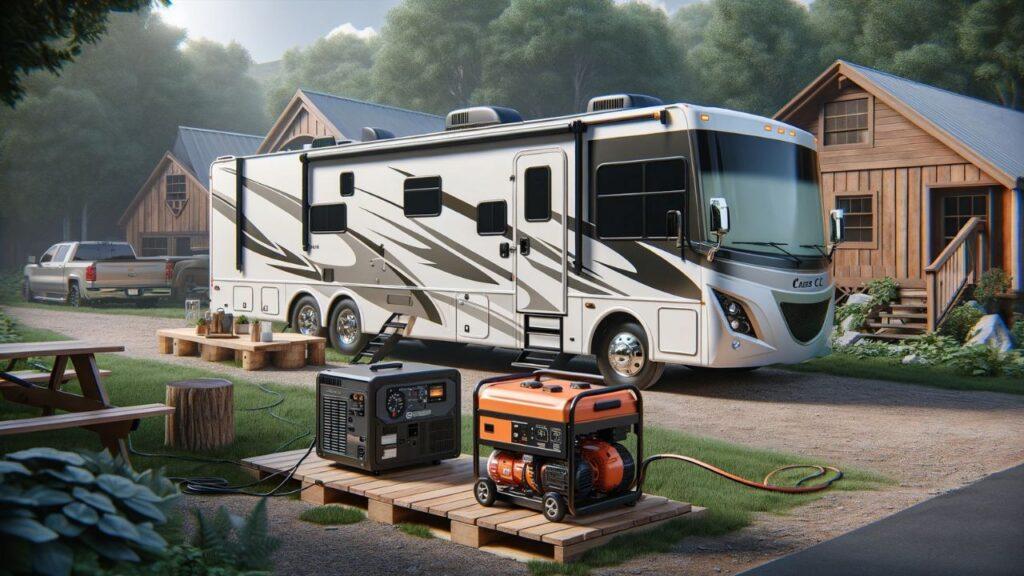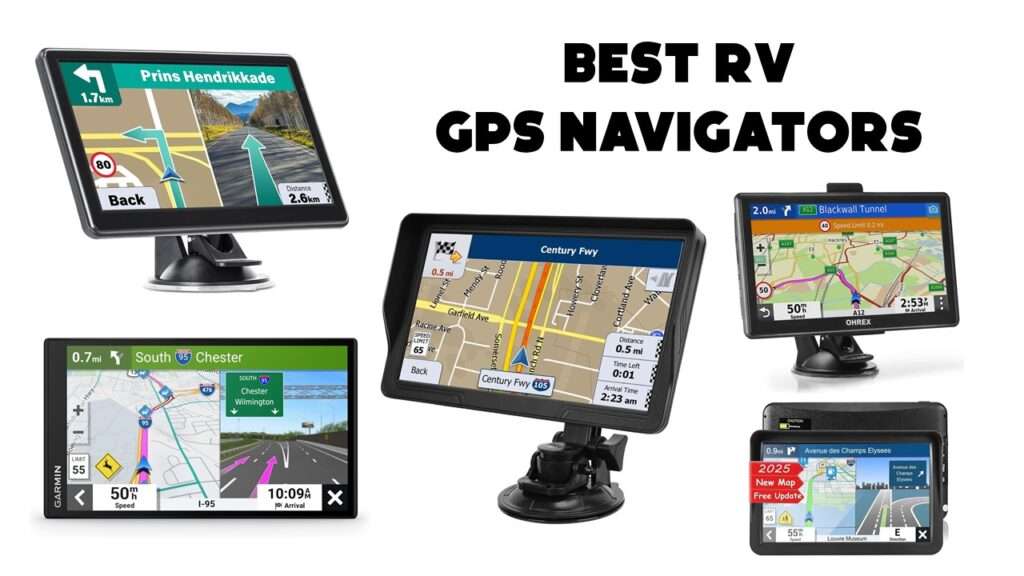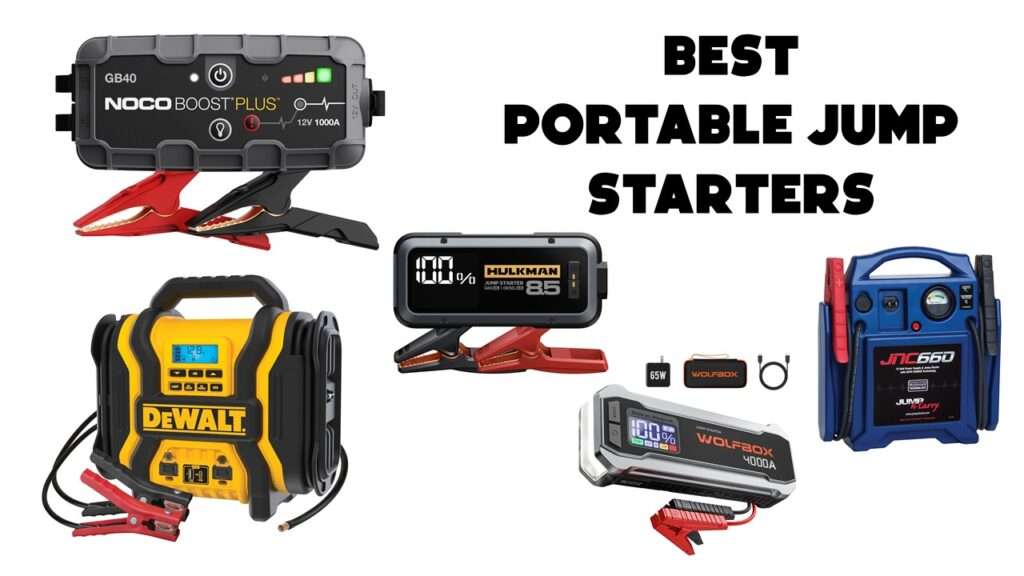If you’re looking for the best weight distribution hitch to make your towing experience smoother, safer, and more stable, you’re in the right place. We’ve tested and reviewed the top weight distribution hitches for all types of towing setups, from weekend RVers to heavy-duty trailer haulers. Whether you need something quiet, budget-friendly, or built for big loads, this guide has you covered. For easier hitching and leveling, pairing it with an electric trailer jack can make setup much faster.
We’re reader-supported. When you buy through links on our site, we may earn an affiliate commission. As an Amazon Associate, we earn from qualifying purchases, at no extra cost to you.
Best Weight Distribution Hitch: Our Top Picks
- Best Overall: Andersen Hitches No-Sway Weight Distribution Hitch 4in Drop/Rise
- Best Budget Option: Reese 49913 Integrated Sway Control Weight Distribution Kit
- Best Heavy-Duty Hitch Under $300: VEVOR Sway Control Weight Distribution Hitch 1,500 lbs
- Best for Custom Adjustments: CURT 17601 TruTrack 2P Round Bar Hitch
- Most Advanced Sway Control System: Equal-i-zer 4-point Sway Control Hitch, 90-00-1600
- Best Mid-Range All-in-One Option: CURT 17062 Round Bar Weight Distribution Hitch
- Best for Heavy Loads on a Budget: CURT 17063 Round Bar Weight Distribution Hitch
- Best for Quick Chain Adjustments: Fastway Connect™ Weight Distribution Hitch
- Best Premium All-Steel Build: Equal-i-zer 4-Point Sway Control & Weight Distribution Hitch
- Best All-in-One Setup for RVs: Reese 49912 Pro Round Bar Weight Distribution Hitch
- Best for Adaptive Sway Control: Camco Eaz-Lift ReCurve R6 Weight Distributing Hitch Kit
- Best Entry-Level Kit with Sway Control: Camco EAZ-Lift Elite 800lb Weight Distribution Hitch Kit
1. Best Overall: Andersen Hitches No-Sway Weight Distribution Hitch 4in Drop/Rise
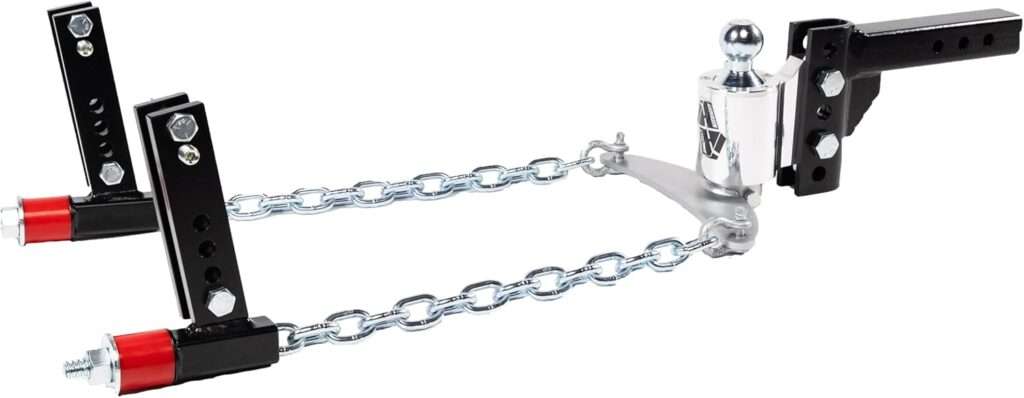
Key Details:
- Tongue bracket compatibility: Fits 3″, 4″, 5″, and 6″ trailer frames
- Hitch ball: 2-5/16″, included
- Material: Alloy Steel with powder-coated finish
- Grease-free system with motion springs and tension chains
After testing the Andersen No-Sway Hitch, it stood out for how smooth and quiet the ride felt, even at highway speeds with crosswinds. Unlike traditional chain-based hitches, Andersen’s design uses motion-dampening springs and a self-adjusting sway control system that doesn’t rely on friction or noise. It’s built for people who want an easy, quiet, and reliable towing setup without needing frequent adjustments.
This hitch also doubles as a standard ball mount when you’re not towing with weight distribution, which adds versatility. And installation is user-friendly with one-pin removal from the tow vehicle. If you’re looking for the best weight distribution hitch that balances innovation with performance, this is it.
The price is on the higher side, but for those towing valuable trailers or traveling long distances, it’s well worth the investment. For a smoother overall towing experience, you might also consider upgrading your RV stabilizer jacks and adjustable trailer hitch to match your setup.
Pros:
- Advanced self-adjusting sway control
- Quiet, grease-free design
- Easy to install and remove
- Works with various frame sizes and shank types
Cons:
- Premium price point
- Some setups may require fine-tuning for best sway control
2. Best Budget Option: Reese 49913 Integrated Sway Control Weight Distribution Kit

Key Details:
- Max gross trailer weight: 11,500 lbs
- Hitch ball size: 2-5/16″, pre-installed
- Includes 8.5” deep drop shank for taller trucks
- Clamp-on brackets—no drilling needed
If you’re looking for the best weight distribution hitch without breaking the bank, the Reese 49913 is a solid pick. It’s designed to improve towing stability with a reliable sway control system and weight distribution bars that keep your setup level and secure. The hitch ball and sway control ball come pre-installed, saving you time during setup.
This kit also includes a deep drop shank, which is great for today’s taller trucks. We found installation straightforward, thanks to clamp-on brackets that eliminate the need for drilling. For occasional haulers, weekend RVers, or budget-conscious buyers, this hitch checks a lot of boxes.
The only trade-off is that it uses a more traditional friction sway system, which can be a bit noisier than higher-end models—but for the price, it’s hard to beat.
Pros:
- Affordable and complete kit
- Pre-installed hitch and sway control balls
- No-drill installation
- Works with frames up to 7 inches
Cons:
- Can be noisy under load
- Not ideal for very heavy trailers or frequent towing
3. Best Heavy-Duty Hitch Under $300: VEVOR Sway Control Weight Distribution Hitch 1,500 lbs
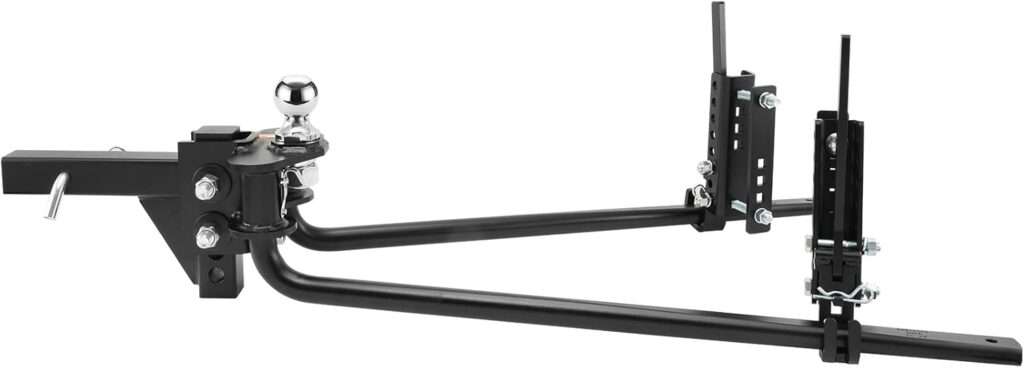
Key Details:
- Tongue weight capacity: 1,500 lbs
- Ball size: 2-5/16″, included
- Built with high-tensile alloy steel
- Dual rust-resistant electroplating
For those towing heavier loads but sticking to a budget, the VEVOR Weight Distribution Hitch is a surprising powerhouse. We were impressed with the build quality for the price—this thing is forged from high-tensile alloy steel and handles tough conditions with ease. It’s especially well-suited for long-distance hauls or cold, windy weather where trailer sway tends to act up.
The real standout here is the four-way dynamic stability system, which resists motion from all directions. It made reversing and sharp turns feel more controlled during testing. It also includes rust-resistant coating and a tilt-head design that allows for easy height adjustments without disassembling the whole unit.
It’s not the most well-known brand, and the manual could be clearer, but overall it’s one of the top weight distribution hitch options under $300 for heavy-duty users.
Pros:
- Great value for high tongue weight
- Solid sway and weight distribution performance
- Adjustable height without disassembly
- All-weather protection
Cons:
- Brand is less recognized
- Instructions could be better
4. Best for Custom Adjustments: CURT 17601 TruTrack 2P Round Bar Hitch
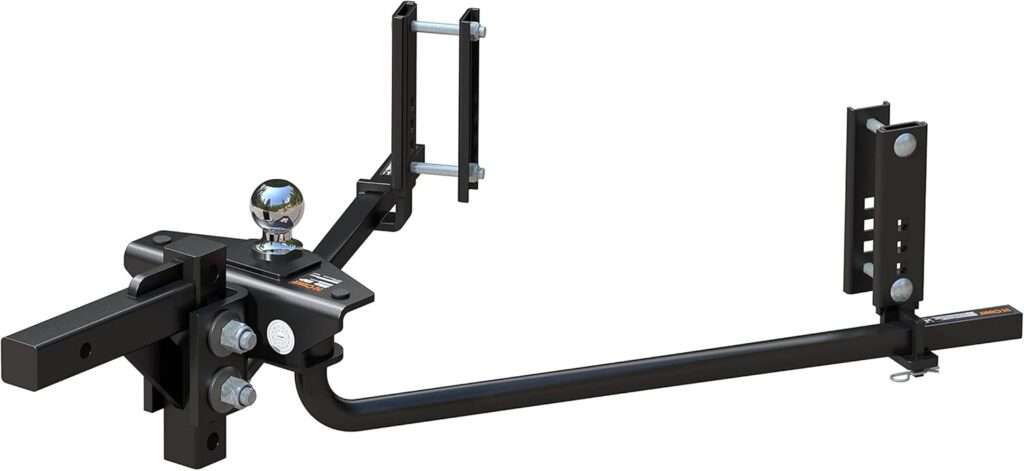
Key Details:
- Tongue weight capacity: 800–1,000 lbs
- Gross trailer weight: Up to 10,000 lbs
- Includes 2″ shank and 2-5/16″ ball
- Integrated dual-point sway control system
The CURT TruTrack 2P stands out for how customizable it is. Whether you’re fine-tuning the tilt head or adjusting the 7-hole shank, this hitch gives you full control over your towing setup. When we tested it, it performed very well in windy and uneven terrain thanks to its dual-point sway control system.
This weight distribution hitch is especially helpful if you’re switching between trailers or have varying load sizes. It’s also backed by CURT’s reliable construction and a durable powder coat finish that holds up well over time. Setup takes a little longer, but the precision is worth it.
If you want a top weight distribution hitch that gives you room to dial in the perfect fit, the TruTrack 2P is a strong contender.
Pros:
- Highly adjustable for different trailers
- Integrated sway control
- Durable build quality
- Smooth and quiet towing
Cons:
- Setup may take longer than simpler kits
- Not ideal for very small trailers
5. Most Advanced Sway Control System: Equal-i-zer 4-point Sway Control Hitch, 90-00-1600
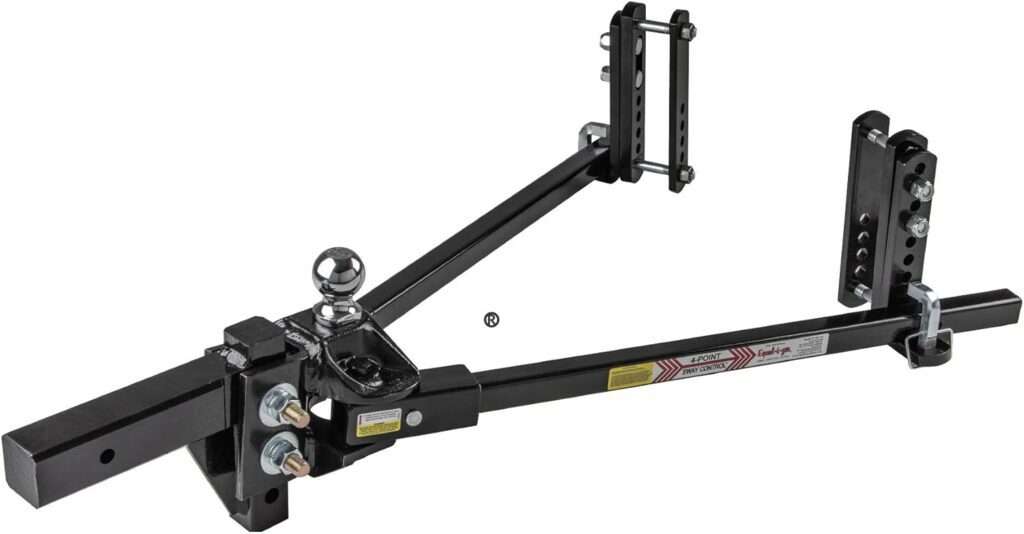
Key Details:
- Tongue weight capacity: 1,600 lbs
- Gross trailer weight: 16,000 lbs
- Includes pre-installed hitch ball and standard shank
- Compatible with surge brake trailers
The Equal-i-zer is one of the most trusted names in towing, and their 4-Point Sway Control Hitch shows why. When we were testing it with a loaded camper, the sway control felt immediate and consistent—no clunks, no delay. Unlike systems that rely on separate sway bars, this hitch integrates sway control directly into the weight distribution arms, offering a more stable ride with fewer moving parts.
It’s built for larger trailers and demanding hauls, making it ideal for full-time RVers or anyone towing high-value cargo. Setup is straightforward once you get the hang of the torque specs, and you can hitch from different angles, which is a big help when parking isn’t perfect.
If you’re looking for the best weight distribution hitch with serious sway control and high towing capacity, this is it. It’s a premium option—but backed by a lifetime warranty and made in the USA.
Pros:
- Best-in-class 4-point sway control
- Handles very heavy trailers with ease
- Durable, American-made construction
- Lifetime warranty included
Cons:
- Higher cost than most competitors
- Slight learning curve during setup
6. Best Mid-Range All-in-One Option: CURT 17062 Round Bar Weight Distribution Hitch
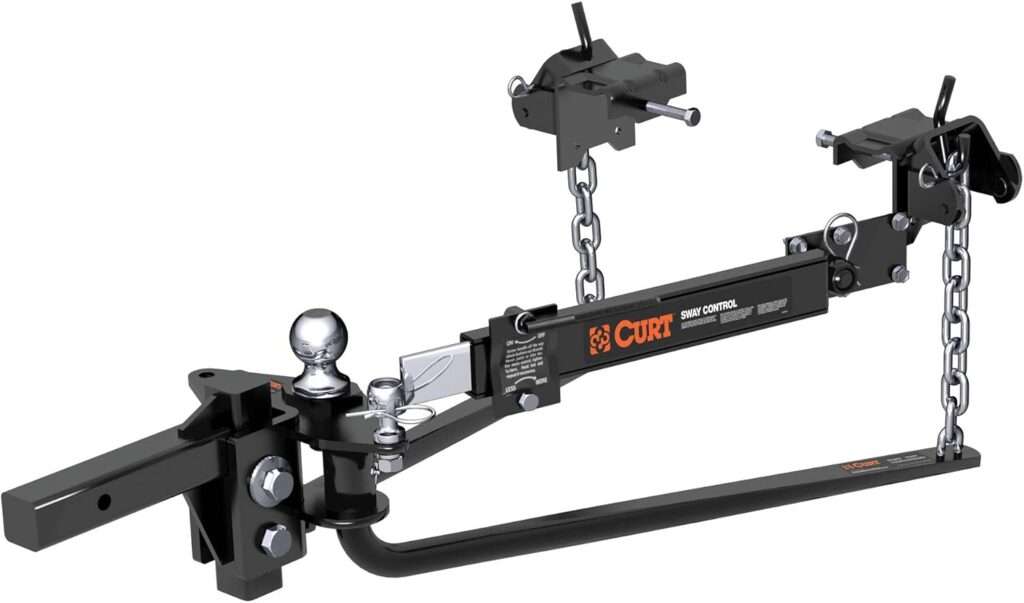
Key Details:
- Towing capacity: Up to 10,000 lbs
- Tongue weight: 800–1,000 lbs
- Integrated sway control bar included
- Continuous lubrication system with grease fittings
This CURT 17062 model is a reliable, mid-priced option that includes everything you need in one kit—spring bars, hitch ball, sway control, and even grease zerk fittings for smoother towing. We appreciated how balanced the ride felt when towing over bumps and curves. The integrated sway bar kept the trailer in line even during windy highway stretches.
What really makes this hitch stand out is the built-in lubrication system. The grease points make it easy to maintain without disassembling anything, which adds a lot of long-term value.
If you’re looking for a top weight distribution hitch that’s easy to set up, low on maintenance, and still budget-friendly, this CURT model delivers well across the board.
Pros:
- Includes sway control and ball out of the box
- Quiet and smooth thanks to integrated lubrication
- Strong build for mid-weight trailers
- Easy to install and adjust
Cons:
- Not suitable for loads above 10,000 lbs
- Fixed sway control bar isn’t adjustable
7. Best for Heavy Loads on a Budget: CURT 17063 Round Bar Weight Distribution Hitch

Key Details:
- Towing capacity: 10,000–14,000 lbs
- Tongue weight: 1,000–1,400 lbs
- 2-inch shank and pre-installed 2-5/16-inch ball
- Integrated sway control and lubrication system
The CURT 17063 is essentially a heavy-duty version of the 17062, built to handle bigger trailers without stepping into premium price territory. It’s ideal for large toy haulers, enclosed cargo trailers, or big campers. When we tested it with a 12,000 lb trailer, it leveled the load impressively and reduced sway even with gusty crosswinds.
Like its sibling, it includes an integrated lubrication system, which helps reduce wear and noise over time. The spring bars are forged steel and the powder-coated finish adds extra corrosion resistance.
If you want a high-capacity, no-fuss hitch that doesn’t blow your budget, this is one of the best weight distribution hitches in its price range.
Pros:
- Handles large trailer loads up to 14,000 lbs
- Integrated sway control works reliably
- Grease zerks keep things running smooth
- Strong build at a good value
Cons:
- A bit heavier and bulkier
- Not ideal for light trailers or small SUVs
8. Best for Quick Chain Adjustments: Fastway Connect™ Weight Distribution Hitch
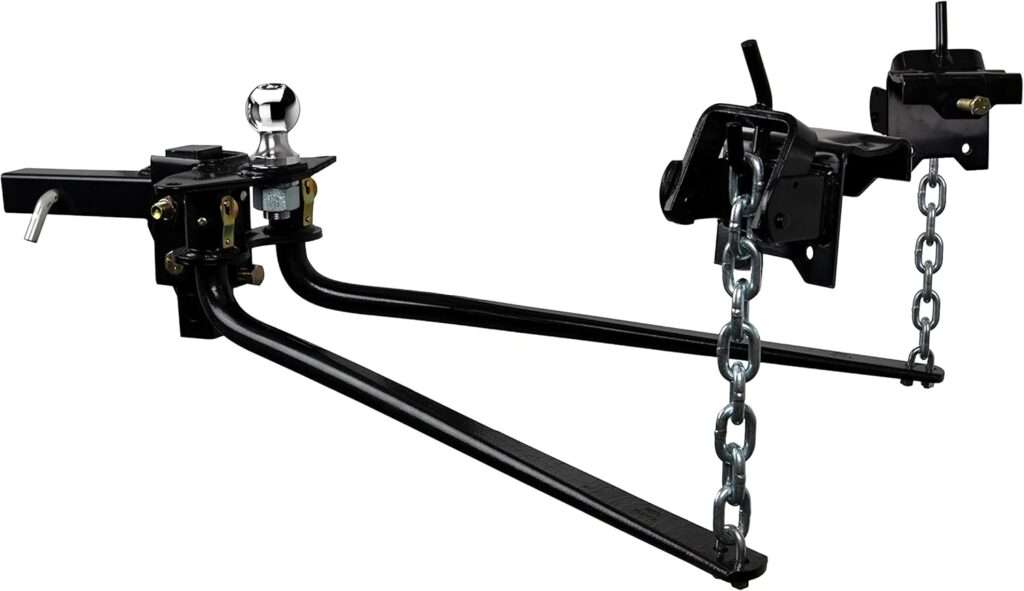
Key Details:
- Tongue weight: 1,000 lbs
- Max trailer weight: 10,000 lbs
- Hitch ball: 2-5/16”, pre-installed
- Material: Alloy steel, powder-coated finish
- No-drill installation; 3″ drop / 7″ rise standard shank
The Fastway Connect Weight Distribution Hitch keeps things simple yet solid for everyday towing. During the test, we liked how quickly it allowed chain adjustments—just move one link up or down to balance tongue weight and level the trailer. The hardened steel chains provide dependable tension, giving better steering and braking stability without complicated hardware.
The setup process is beginner-friendly and doesn’t require frame drilling, which makes it appealing for users who tow multiple trailers like RVs, boats, or cargo haulers. Despite its straightforward design, it performs well in controlling sway and keeping the rig stable under moderate wind and traffic conditions.
If you want a reliable, no-nonsense hitch that’s easy to use and priced right, the Fastway Connect is a great all-rounder that offers dependable load distribution for daily towing.
Pros:
- Simple and fast chain adjustment system
- Strong sway and load control for its class
- No-drill, universal fit across trailer types
- Includes pre-installed hitch ball and standard shank
Cons:
- Chains can rattle slightly on rough roads
- Not ideal for very heavy fifth-wheel setups
9. Best Premium All-Steel Build: Equal-i-zer 4-Point Sway Control & Weight Distribution Hitch

Key Details:
- Tongue weight: 1,600 lbs
- Gross trailer weight: 16,000 lbs
- Integrated 4-point sway control system
- Works with surge brake trailers
- Lifetime warranty, made in USA
The Equal-i-zer 90-00-1669 represents the pinnacle of towing technology for those hauling large campers, horse trailers, or heavy RV setups. When we tested it, the integrated 4-point sway control engaged immediately—keeping the trailer perfectly in line, even in crosswinds and on uneven roads. The all-steel, American-made construction feels bulletproof, and the powder-coated finish protects it from rust for years of use.
Installation is straightforward, and hitching can be done from multiple angles—something we found very helpful when aligning on unlevel ground. Once connected, it provides a quiet, level, and confident towing experience.
For serious haulers who prioritize stability and safety, the Equal-i-zer is one of the most advanced and well-built weight distribution hitches you can buy.
Pros:
- Patented 4-point integrated sway control
- Superior stability and braking balance
- Lifetime warranty with American steel build
- Works on most trailer types, including surge brake models
Cons:
- Premium price
- Slightly heavier than typical mid-range hitches
10. Best All-in-One Setup for RVs: Reese 49912 Pro Round Bar Weight Distribution Hitch

Key Details:
- Max tongue weight: 800 lbs
- Max trailer weight: 8,000 lbs
- Hitch ball: 2-5/16”, pre-installed
- Drop shank: 8.5-inch deep
- Clamp-on brackets fit up to 7-inch trailer frames
The Reese 49912 Pro Round Bar Hitch delivers classic performance with modern convenience. Designed for RV and camper owners, it evenly distributes weight across the axles to keep your tow vehicle level and stable. During our testing, we found that the tapered spring bars and friction sway control worked well to reduce side-to-side motion, especially on highways and winding backroads.
Everything you need comes in the box—pre-installed hitch ball, lift-assist bar, shank, and brackets—so setup is straightforward even for first-timers. The high-strength steel head and powder-coated finish ensure durability, and the clamp-on design avoids drilling.
For those wanting a balanced combination of comfort, control, and simplicity, the Reese 49912 remains one of the most trusted and complete kits under $300.
Pros:
- Complete kit with all parts pre-installed
- Smooth and stable ride for most RV setups
- Durable, long-lasting construction
- Easy no-drill installation
Cons:
- Friction sway control can be a bit noisy
- Not ideal for very heavy or commercial trailers
11. Best for Adaptive Sway Control: Camco Eaz-Lift ReCurve R6 Weight Distributing Hitch Kit

Key Details:
- Tongue weight capacity: 1,000 lbs
- Adaptive sway control with reduced noise
- Fits 3″ to 6″ A-frames
- Powder-coated, rust-resistant finish
The Camco Eaz-Lift ReCurve R6 is a smart option for those who want a hitch that adapts as you drive. Its built-in sway control automatically adjusts based on trailer movement, providing a smoother experience when turning or changing lanes. During testing, it reduced sway noticeably without needing manual adjustments—perfect for new or occasional towers.
This model is also quieter than many friction-based hitches, which makes a big difference on long drives. It’s compatible with common trailer frame sizes, and the design is fairly intuitive for DIY installation. If you’re after a top weight distribution hitch that gives you sway control without extra fuss, this is one to consider.
Just note that it’s a bit pricier than entry-level kits, so it may not be the best fit if you’re towing very light loads or just getting started.
Pros:
- Adaptive sway control that adjusts on the fly
- Quiet operation
- Clean, heavy-duty design
- Easy to install on standard trailer frames
Cons:
- Price may be high for casual users
- Slightly bulkier than some hitches
12. Best Entry-Level Kit with Sway Control: Camco EAZ-Lift Elite 800lb Weight Distribution Hitch Kit
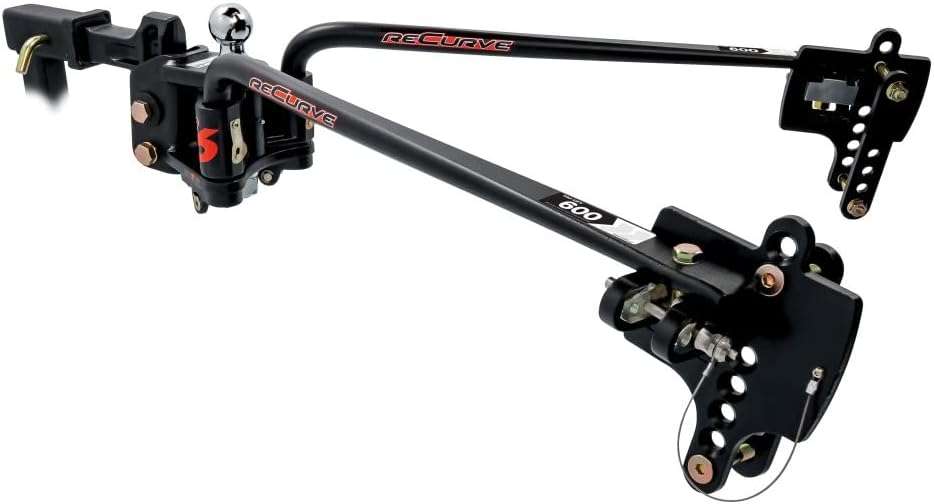
Key Details:
- Max tongue weight: 1,000 lbs
- Max gross trailer weight: 10,000 lbs
- Includes sway control and pre-installed hitch ball
- Spring bars can be used on either side
For those just getting started with towing, the Camco EAZ-Lift Elite kit offers a complete, user-friendly package. Everything comes pre-installed—hitch ball, sway control ball, spring bars—so it’s easy to set up even if you’ve never used a weight distribution hitch before.
While it uses a traditional friction-style sway control, we found it to be quite effective during moderate wind and traffic conditions. It’s especially handy that the sway control can be manually adjusted or turned off, depending on your preferences.
It’s not designed for very heavy loads, but for small to mid-sized trailers, this hitch kit is one of the top weight distribution hitches to consider at this price point.
Pros:
- All-in-one kit with pre-installed parts
- Easy for first-time users
- Manual sway control adjustment
- Good build quality for the price
Cons:
- Friction sway control can get noisy
- Less effective for high-speed or heavy hauls
What Is a Weight Distribution Hitch?
A weight distribution hitch is a towing device that helps evenly distribute the tongue weight of a trailer across the axles of both the tow vehicle and the trailer. This prevents the rear of the tow vehicle from sagging and keeps the entire setup more level and stable.
In simple terms, it spreads out the weight so that the front wheels of the tow vehicle stay planted on the road. This improves handling, braking, and steering—especially when towing heavy loads or driving in windy or uneven conditions.
Weight distribution hitches often come with built-in sway control, which adds another layer of safety by preventing the trailer from swaying side to side. Some models use friction bars, while others use adaptive or integrated systems that adjust as you drive.
What Does a Weight Distribution Hitch Do?
A weight distribution hitch balances the load between your vehicle and trailer to improve towing performance and safety. It keeps your setup level and reduces stress on the rear axle of your vehicle.
- Distributes tongue weight across all axles
- Prevents rear-end sagging and front-end lift
- Improves steering, braking, and control
- Reduces trailer sway and bouncing
- Helps extend the life of your suspension system
Who Needs a Weight Distribution Hitch?
If you’re towing a trailer over a certain weight, or experiencing sway and poor handling, a weight distribution hitch is highly recommended.
- RVers towing travel trailers or campers over 5,000 lbs
- Pickup truck owners hauling boats, horse trailers, or enclosed trailers
- Van lifers towing additional cargo or gear trailers
- Anyone experiencing trailer sway or uneven load balance
- Drivers who frequently tow in wind, hills, or long distances
How to Choose the Best Weight Distribution Hitch
Picking the best weight distribution hitch comes down to your trailer size, towing vehicle, and how much control and customization you want.
Know Your Tongue Weight and Trailer Weight
Before buying, check the gross trailer weight (GTW) and tongue weight (TW) of your setup. Your hitch must be rated to handle both. A mismatch can lead to poor handling or even damage.
Look for Sway Control (and Understand the Type)
Some hitches come with built-in sway control, while others use add-on friction bars. Adaptive sway control systems auto-adjust as you drive. If you tow in windy areas or at highway speeds, integrated sway control is a must.
Consider Your Vehicle Height and Drop/Rise Needs
Trucks and SUVs with lifted suspensions or tall frames may need a hitch with a deep drop or rise to stay level. Look for adjustable shank options that can match your height.
Ease of Installation and Use
Some hitches come pre-assembled with all the hardware, making them ideal for beginners. Others require more time to install and fine-tune but offer greater adjustability.
Build Quality and Long-Term Durability
If you tow frequently or in tough conditions, prioritize hitches made with forged steel and corrosion-resistant coatings. Features like grease zerks or maintenance-free designs also help with longevity.
Weight Distribution Hitch vs. Sway Bar: What’s the Difference?
A weight distribution hitch levels out your towing setup by spreading the trailer’s tongue weight across all axles, while a sway bar is designed to reduce side-to-side trailer movement caused by wind or sharp turns. Both improve towing safety, but they serve different purposes—and in many cases, they’re used together.
If you’re towing a heavier trailer or driving in windy areas, you may benefit from both systems. Many modern weight distribution hitches now come with built-in sway control, offering the best of both worlds. Here’s a quick comparison to help you decide:
| Feature | Weight Distribution Hitch | Sway Bar |
| Primary Function | Levels weight across vehicle and trailer axles | Reduces side-to-side trailer sway |
| Improves Braking & Steering | Yes | Not directly |
| Helps Prevent Rear Sag | Yes | No |
| Needed for Heavy Trailers | Yes (over 5,000 lbs recommended) | Optional add-on |
| Installation Complexity | Moderate | Simple |
| Often Included in Hitch Kit | Yes (in integrated models) | Sometimes sold separately |
How to Install a Weight Distribution Hitch
Installing a weight distribution hitch isn’t overly complex, but it does require the right tools and proper alignment. Here’s a simple step-by-step guide to get you started:
- Step 1: Park your tow vehicle and trailer on a flat, level surface. Chock the trailer wheels for safety.
- Step 2: Measure the height of the trailer coupler and the tow vehicle’s hitch receiver to determine the correct drop/rise.
- Step 3: Attach the adjustable shank to your hitch receiver. Install the hitch head with the ball facing the trailer.
- Step 4: Back your vehicle up and lower the trailer coupler onto the hitch ball.
- Step 5: Install the spring bars into the hitch head.
- Step 6: Attach the trailer frame brackets and connect the spring bars using chains or trunnion arms.
- Step 7: Use a lift tool or jack to tension the spring bars and level the trailer.
- Step 8: Double-check your angles, connections, and torque specs per the manufacturer’s instructions.
- Step 9: Test-drive your setup and make any fine-tuning adjustments to bar tension or head tilt.
Final Words
Towing can be stressful—but the right gear can make it a whole lot safer and smoother. Whether you’re hauling a travel trailer for the weekend or towing cross-country with a heavy load, using a weight distribution hitch is one of the best decisions you can make for stability and control.
From budget-friendly kits to top-tier systems with adaptive sway control, we’ve tested a wide range of options to help you find the perfect fit. If you want the most well-rounded performance with minimal noise, easy setup, and built-in sway protection, the Andersen Hitches No-Sway Weight Distribution Hitch is still our top recommendation.
We hope this guide helped you narrow down your choices and feel more confident about your towing setup. Stay safe—and enjoy the road ahead.
FAQs
Do I really need a weight distribution hitch?
If your trailer weighs more than 5,000 lbs or your tow vehicle sags in the rear when hitched up, a weight distribution hitch is highly recommended. It improves handling, braking, and overall safety.
How do I know if my trailer needs a weight distribution hitch?
Check your owner’s manual for towing guidelines. If you notice rear-end sag, reduced steering control, or sway while driving, it’s a good sign that you need one.
Can I back up with a weight distribution hitch installed?
Yes, but it depends on the model. Some hitches (especially with friction-style sway bars) require sway control to be disabled before reversing. Always check your hitch instructions.
Do I need sway control with a weight distribution hitch?
If you tow at highway speeds, in windy conditions, or with a longer trailer, sway control is strongly recommended. Many modern hitches include it as a built-in feature.
What happens if I tow without a weight distribution hitch?
Without a weight distribution hitch, your tow vehicle may sag, handle poorly, and take longer to stop. It can also increase trailer sway and stress on your suspension.

Jack Rivers is a long-time RVer, a husband, and a dad who’s traveled solo and now with his family. He’s learned a lot from years on the road, sometimes the hard way. From quiet mornings parked by the woods to messy evenings with the kids and a busted heater, he’s been through it all. Miles writes to share the real stuff, the small wins, and the lessons that make RV life worth it, no matter who you’re traveling with.

